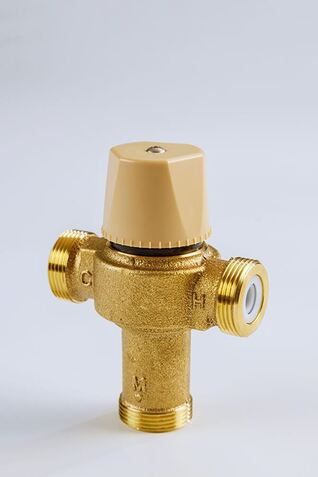What Is a Thermostatic Expansion Valve?

A thermostatic expansion valve is used in all newer models of air conditioning units. Its primary function is to regulate the flow of refrigerant into the evaporator, and without it, your air conditioning system would cease to function efficiently.
The Definition of a Thermostatic Expansion Valve
A thermostatic expansion valve goes by a few different names such as thermal expansion valve or abbreviations like TXV or TEV. The whole device consists of a metal main body with two tubes coming out of either side, copper wire and capillary tube connections, and a slender glass container off of one side that serves as the sensing bulb. Of course, a lot of different designs for a thermostatic expansion valve are out there, but they all come back to this same basic configuration.
The TXV is always located near an air conditioner’s evaporator, as the sensing bulb has to be placed inside the evaporator unit in order to sense any evaporation at all. Sometimes, you can see the TXV outside of your air conditioner’s air handler (located inside your home or building), but in other situations, it will be hidden inside.
How a Thermostatic Expansion Valve Works
Refrigerant is released outside through the compressor and is turned into a highly pressurized gas. After entering the condenser, also outside, the refrigerant is condensed into a liquid, still at high pressure. Then, it is transported through tubing that leads to the indoor air handler. In the air handler, the refrigerant liquid is forced to pass through the TXV before coming out through the evaporator in a cooled, gaseous state. This is the simplified flow of the process, but the thermostatic expansion valve has a more detailed part to play.
Since the refrigerant comes into the TXV through one side with very high pressure, it is slowed and spun around inside the valve before being squeezed out the other side at a lower pressure. This lowered pressure is achieved because the liquid refrigerant is released from a small tube to a slightly larger one where the refrigerant can “breathe” and find more space to fill. The refrigerant also partially turns back into a gas at this point, and it will go on to completely become cooled gas in the evaporator that the TXV leads to.
Why a Thermostatic Expansion Valve Is Important
For one thing, without the TXV in place to convert the liquid refrigerant from high to low pressure, the refrigerant would just go straight to the evaporator too quickly, and this could cause damage to the evaporator and its internal parts.
All thermostatic expansion valves also include a sensing bulb inside the evaporator, and this sensor is used to control the flow of refrigerant to the evaporator even further. If the sensor indicates that the refrigerant inside the evaporator is too hot, the opening from the valve to the evaporator will open up to let more refrigerant in, cooling the flow and slowing it down. If the sensor indicates that the refrigerant inside is too cold, though, the opening will close up and let less refrigerant in, making the flow hotter and quicker.
Because the thermostatic expansion valve includes this sensing bulb, a more efficient air conditioning system can be achieved. If you think about it, you’ll see that it’s an elegant scheme. The TXV will only release extra refrigerant as needed rather than allowing a steady flow of it through all the time. This actually extends the life of the refrigerant and decreases the amount of energy needed to create cool air.
How to Know a Thermostatic Expansion Valve Is Working
To put it simply, if your air conditioner is running at regular intervals and delivering a comfortable airflow to your building, then you know your thermostatic expansion valve is working. However, if you notice that your air conditioner is running constantly, your air vents are not sending out cool air or your vents have signs of frost on them, you may have a faulty TXV.
If you believe your thermostatic expansion valve is not working properly, reach out to us a Jeffries Heating & Air + Plumbing. Even if your TXV is not to blame, we will be able to identify the source of any problems you are experiencing with your air conditioning system and fix them efficiently for you. Our technicians are highly trained, and we have an A+ rating with the BBB. The experts on our crew routinely assist people throughout Somerset and the surrounding areas with heating and cooling services, including installation, maintenance and repair. You can rely on us for a full range of plumbing services as well. Give us a call today.
